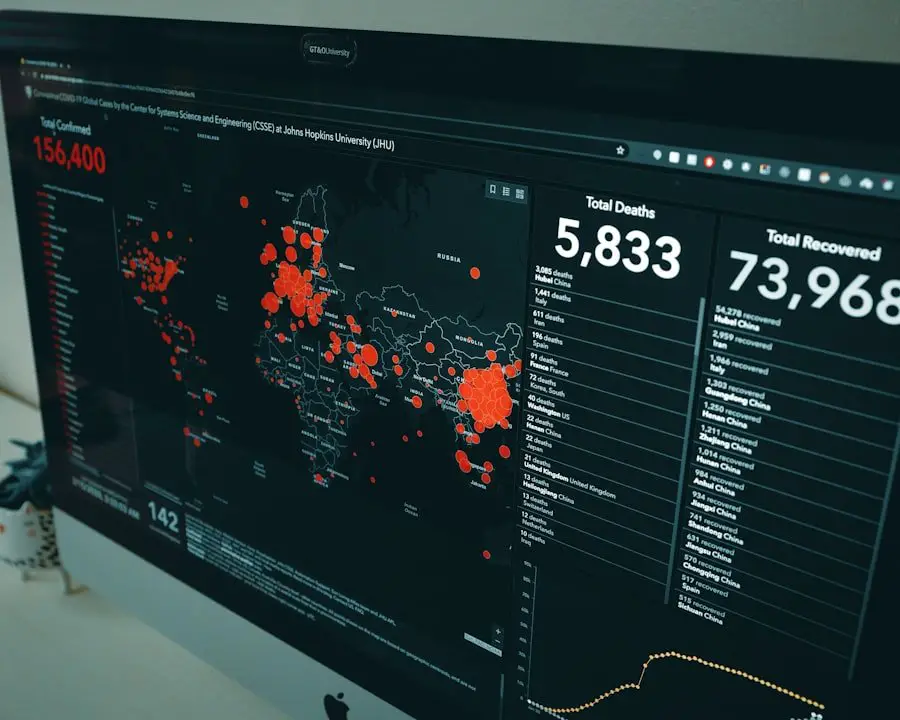Data science is a rapidly growing field that involves the use of various tools and techniques to analyze and interpret complex data sets. Data scientists rely on a range of tools to collect, clean, analyze, and visualize data effectively. Common data science tools include programming languages such as Python, R, and SQL, as well as data visualization software like Tableau and Power BI.
These tools enable data scientists to manipulate large data sets, uncover patterns and trends, and communicate findings effectively. Machine learning libraries such as TensorFlow and scikit-learn are also essential components of the data science toolkit, allowing professionals to build and train predictive models. These tools empower data scientists to extract valuable insights from data and make informed business decisions.
Data science tools play a crucial role in enabling professionals to work with data in a meaningful and impactful way. By leveraging these tools, data scientists can collect and clean large datasets, perform complex analyses, and create visualizations that effectively communicate their findings. This process leads to valuable insights for businesses and organizations, ultimately driving data-driven decision-making across various industries.
Key Takeaways
- Data science tools are essential for collecting, cleaning, and analyzing data to derive insights and make informed decisions.
- Data visualization helps in presenting complex data in a visual format, making it easier to understand and interpret patterns and trends.
- Machine learning algorithms enable computers to learn from data and make predictions or decisions without being explicitly programmed.
- Big data technologies like Hadoop and Spark are used to process and analyze large volumes of data efficiently and cost-effectively.
- Statistical analysis is crucial for interpreting data, identifying patterns, and making predictions based on probability and likelihood.
Understanding Data Visualization
Effective Communication of Complex Information
Data visualization tools such as Tableau, Power BI, and matplotlib enable data scientists to create interactive and informative visualizations that help stakeholders understand the significance of the data.
Exploratory Data Analysis
Data visualization plays a key role in exploratory data analysis, allowing data scientists to gain insights into the underlying structure of the data and identify potential relationships between variables.
A Powerful Tool for Data Science
Ultimately, data visualization is a powerful tool that enables professionals to make sense of complex data and communicate their findings in a compelling manner. It is an essential component of the data science process, enabling professionals to communicate their findings in a clear and impactful way.
Exploring Machine Learning Algorithms

Machine learning algorithms are at the core of many data science applications, enabling computers to learn from data and make predictions or decisions without being explicitly programmed. These algorithms can be categorized into supervised learning, unsupervised learning, and reinforcement learning, each serving different purposes in the field of data science. Supervised learning algorithms are used for tasks where the model is trained on labeled data to make predictions, while unsupervised learning algorithms are used for tasks where the model is trained on unlabeled data to discover patterns or groupings within the data.
Reinforcement learning algorithms involve training an agent to make sequential decisions in an environment in order to maximize some notion of cumulative reward. By leveraging these machine learning algorithms, data scientists can build predictive models that can be used for a wide range of applications, from recommendation systems to fraud detection. Machine learning algorithms are at the core of many data science applications, enabling computers to learn from data and make predictions or decisions without being explicitly programmed.
These algorithms can be categorized into supervised learning, unsupervised learning, and reinforcement learning, each serving different purposes in the field of data science. Supervised learning algorithms are used for tasks where the model is trained on labeled data to make predictions, while unsupervised learning algorithms are used for tasks where the model is trained on unlabeled data to discover patterns or groupings within the data. Reinforcement learning algorithms involve training an agent to make sequential decisions in an environment in order to maximize some notion of cumulative reward.
By leveraging these machine learning algorithms, data scientists can build predictive models that can be used for a wide range of applications, from recommendation systems to fraud detection.
Leveraging Big Data Technologies
| Metrics | Data |
|---|---|
| Volume | Large amounts of data generated |
| Variety | Data comes in different formats (structured, unstructured, semi-structured) |
| Velocity | Data is generated at high speed |
| Veracity | Data quality and accuracy |
| Value | Extracting meaningful insights from data |
Big Data technologies are essential for handling large volumes of structured and unstructured data that cannot be processed with traditional database management tools. These technologies include distributed storage systems like Hadoop Distributed File System (HDFS) and distributed processing frameworks like Apache Spark. HDFS enables the storage of large datasets across clusters of commodity hardware, while Apache Spark provides a fast and general-purpose cluster computing system for big data processing.
By leveraging these Big Data technologies, organizations can efficiently store, process, and analyze massive amounts of data to gain valuable insights that can drive business decisions. Additionally, these technologies enable real-time processing of streaming data, allowing organizations to make timely decisions based on up-to-date information. Big Data technologies are essential for handling large volumes of structured and unstructured data that cannot be processed with traditional database management tools.
These technologies include distributed storage systems like Hadoop Distributed File System (HDFS) and distributed processing frameworks like Apache Spark. HDFS enables the storage of large datasets across clusters of commodity hardware, while Apache Spark provides a fast and general-purpose cluster computing system for big data processing. By leveraging these Big Data technologies, organizations can efficiently store, process, and analyze massive amounts of data to gain valuable insights that can drive business decisions.
Additionally, these technologies enable real-time processing of streaming data, allowing organizations to make timely decisions based on up-to-date information.
Harnessing the Power of Statistical Analysis
Statistical analysis is a fundamental aspect of data science that involves the use of statistical methods to collect, analyze, interpret, and present data. By applying statistical techniques such as hypothesis testing, regression analysis, and correlation analysis, data scientists can uncover meaningful insights from complex datasets. These insights can then be used to make informed business decisions or predictions about future outcomes.
Statistical analysis also plays a crucial role in experimental design, enabling researchers to design experiments that yield valid and reliable results. Overall, statistical analysis is an essential tool for data scientists to extract valuable insights from data and make evidence-based decisions. Statistical analysis is a fundamental aspect of data science that involves the use of statistical methods to collect, analyze, interpret, and present data.
By applying statistical techniques such as hypothesis testing, regression analysis, and correlation analysis, data scientists can uncover meaningful insights from complex datasets. These insights can then be used to make informed business decisions or predictions about future outcomes. Statistical analysis also plays a crucial role in experimental design, enabling researchers to design experiments that yield valid and reliable results.
Overall, statistical analysis is an essential tool for data scientists to extract valuable insights from data and make evidence-based decisions.
Implementing Data Mining Techniques

Types of Data Mining Techniques
Some common data mining techniques include clustering analysis, association rule mining, and anomaly detection. Clustering analysis involves grouping similar objects together based on predefined criteria, while association rule mining identifies patterns that describe relationships between variables in large datasets. Anomaly detection aims to identify outliers or abnormalities within the dataset that may indicate potential issues or opportunities for further investigation.
Benefits of Data Mining
By implementing these data mining techniques, organizations can gain valuable insights from their data that can drive business strategies and decision-making processes. Data mining can help organizations uncover hidden patterns and relationships in their data, leading to more informed decision-making and improved business outcomes.
Applications of Data Mining
Data mining has a wide range of applications across various industries, including marketing, finance, healthcare, and more. By applying data mining techniques, organizations can identify new business opportunities, optimize operations, and improve customer relationships.
Utilizing Artificial Intelligence in Data Science
Artificial intelligence (AI) plays a significant role in the field of data science by enabling machines to perform tasks that typically require human intelligence. AI techniques such as natural language processing (NLP), image recognition, and speech recognition are increasingly being used in various applications within the field of data science. NLP allows machines to understand and interpret human language, enabling them to analyze text-based datasets for sentiment analysis or information extraction.
Image recognition enables machines to identify objects within images or videos, while speech recognition allows machines to transcribe spoken language into text. By utilizing AI techniques in data science applications, organizations can automate repetitive tasks, gain deeper insights from unstructured datasets, and improve decision-making processes. Artificial intelligence (AI) plays a significant role in the field of data science by enabling machines to perform tasks that typically require human intelligence.
AI techniques such as natural language processing (NLP), image recognition, and speech recognition are increasingly being used in various applications within the field of data science. NLP allows machines to understand and interpret human language, enabling them to analyze text-based datasets for sentiment analysis or information extraction. Image recognition enables machines to identify objects within images or videos, while speech recognition allows machines to transcribe spoken language into text.
By utilizing AI techniques in data science applications, organizations can automate repetitive tasks, gain deeper insights from unstructured datasets, and improve decision-making processes. In conclusion,data science is a rapidly evolving field that relies on a variety of tools and techniques to extract valuable insights from complex datasets. From programming languages and machine learning algorithms to big data technologies and statistical analysis,data scientists have a wide array of tools at their disposal to work with large volumes of structured and unstructured datasets.Data visualization,data mining techniques,and artificial intelligence also play crucial roles in enabling professionals to communicate their findings effectively,gain valuable insights,and automate repetitive tasks.With the continued advancement of technology,data science will continue to evolve,and professionals will need to stay abreast of new tools and techniques in order to effectively work with complex datasets in the future.
If you’re interested in the future of spatial computing, you might want to check out this article on the Apple Vision Pro, which offers a glimpse into the future of this technology. It’s fascinating to see how advancements in spatial computing could potentially impact the field of data science. (source)
FAQs
What are the essential tools for data science?
Essential tools for data science include programming languages such as Python and R, data visualization tools like Tableau and Power BI, statistical tools like SAS and SPSS, and big data platforms like Hadoop and Spark.
What is the role of programming languages in data science?
Programming languages like Python and R are essential for data science as they are used for data manipulation, analysis, and modeling. These languages also have extensive libraries and packages for machine learning and statistical analysis.
How do data visualization tools help in data science?
Data visualization tools like Tableau and Power BI help in data science by allowing users to create interactive and visually appealing charts, graphs, and dashboards to communicate insights and findings from the data.
What are the benefits of using statistical tools in data science?
Statistical tools like SAS and SPSS are used in data science to perform advanced statistical analysis, hypothesis testing, and predictive modeling. These tools help in uncovering patterns and relationships within the data.
What is the significance of big data platforms in data science?
Big data platforms like Hadoop and Spark are crucial in data science for handling and processing large volumes of data. These platforms provide distributed computing and storage capabilities, making it possible to work with massive datasets.




















+ There are no comments
Add yours